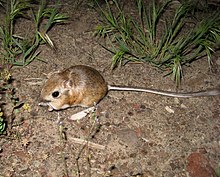Kangaroo mouse
| Kangaroo mouse Temporal range: Late Pleistocene – Recent
| |
|---|---|

| |
| A pale kangaroo mouse in Nevada | |
| Scientific classification | |
| Domain: | Eukaryota |
| Kingdom: | Animalia |
| Phylum: | Chordata |
| Class: | Mammalia |
| Order: | Rodentia |
| Family: | Heteromyidae |
| Subfamily: | Dipodomyinae |
| Genus: | Microdipodops Merriam, 1891 |
| Species | |
A kangaroo mouse is either one of the two species of jumping mouse (genus Microdipodops) native to the deserts of the southwestern United States, predominantly found in the state of Nevada. The name "kangaroo mouse" refers to the species' extraordinary jumping ability, as well as its habit of bipedal locomotion. The two species are:
- Dark kangaroo mouse – Microdipodops megacephalus
- Pale kangaroo mouse – Microdipodops pallidus
Both species of kangaroo mouse live in sandy desert ecosystems, and forage for seeds and vegetation amongst the scrub brush of their native habitat. The dark kangaroo mouse is also known to feed occasionally on insects and carrion. The mouse rarely drinks water, instead deriving it metabolically from the foods it eats. The kangaroo mouse collects food and maintains large caches in their burrows, which are excavated to a length of between 3 and 8 feet (1 to 2.5 meters). The burrow, the entrance to which the mouse covers during daylight hours, is also used to raise litters of between 2 and 7 young. The pale kangaroo mouse burrows only in fine sand, while the dark kangaroo mouse prefers fine, gravelly soils but may also burrow in sand or sandy soil. Kangaroo mice are nocturnal, and are most active in the two hours following sunset. They are believed to hibernate during cold weather. Although mitochondrial data indicate that the clades appear to be in approximate genetic equilibrium and have not suffered any extreme bottlenecks over time, there is still concern for the survival of smaller and more vulnerable Microdipodops subpopulations due to impending habitat threats in the Great Basin Desert.
The kangaroo mice are closely related to the kangaroo rats, which belong to the same subfamily, Dipodomyinae.
See also
- Hopping mouse – a similar murid rodent native to Australia; an example of parallel evolution
- Jerboa – a similar dipodid rodent native to northern Africa and Asia
- Jumping mouse – a non-desert-dwelling dipodid rodent native to China and North America
- Kangaroo rat – a closely related heteromyid rodent of North America
- Rat-kangaroo – a smaller Australian marsupial relative of the kangaroos and wallabies
- Springhare – a similar pedetid rodent native to southern and eastern Africa
References
- Brylski, P. "Dark Kangaroo Mouse". California Department of Fish and Game. Retrieved 2011-07-15.
- Brylski, P. "Pale Kangaroo Mouse". California Department of Fish and Game. Retrieved 2011-07-15.
- "Microdipodops". Integrated Taxonomic Information System. Retrieved 2011-07-15.
- Light J, Hafner J, Upham N, Reddington E, et al. (June 2013). "Conservation Genetics of Kangaroo Mice, Genus Microdipodops". Springer Link. Download PDF Journal of Mammalian Evolution. Retrieved 2018-11-01.
